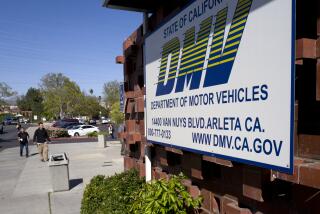When to Stop? : AARP Offers Dozens of Classes to Help Older Drivers Improve Skills and Determine When Itâs Time to Quit
The scenario is familiar: A traffic light turns green, the car at the front of the line hesitates and stalls, and a horn begins to blare. When the cars finally get through the intersection, the irate driver passes the offending vehicle, complaining loudly about senior citizens behind the wheel.
But if the American Assn. of Retired Persons (AARP) can help it, the stereotype of the incompetent older driver will be a thing of the past. Capitalizing on a 10-year-old California law, the nationâs largest senior citizen organization offers dozens of classes monthly in the South Bay to improve its membersâ driving skills, using the enticement of state-mandated insurance rebates for completion of âmature-driverâ courses.
With demographers projecting a surge in the over-55 population between now and 2020--from 30 million to more than 50 million nationwide, according to National Traffic Safety Board estimates--such training is apparently not a moment too soon.
Although focusing on refreshing the knowledge of basic driving skills and rules of the road, the AARP classes also discuss the effects of aging on driving ability, and when it may be time to quit.
âYouâve got to bring that up, because a lot of times people donât think about it,â said Ernest Giaquinto, 70, an AARP volunteer who teaches the organizationâs 55/ALIVE classes. âMy own brother was practically blind before he wore glasses. One lady said her brother is 83 . . . and canât see the street, but yet he gets in his car and drives down to the store.â
Instructors say they are blunt with older people to remind them of the potential hazards. According to Don Treichler, senior traffic specialist for the Automobile Club of Southern California, although drivers over age 55 have fewer accidents annually than other age groups, they have the highest collision rates of any age group per miles driven.
Moreover, in part because of age-induced frailties, their fatality rates are higher for any age group other than young drivers. According to National Traffic Safety Board estimates, about 40% of older drivers refuse to wear safety belts.
Up to age 70, California drivers without moving violations or more than one traffic accident may renew their licenses by mail, but only twice. Thereafter, they are required to pass a written exam and eye test. Driver examiners are permitted discretion about reissuing licenses to those who appear to be marginally competent, Giaquinto said, and can require a road test to determine if an older driver should be driving.
Giaquinto said most students in the AARP classes had many of the same complaints as younger drivers: people who tailgate or change lanes without signaling, and people who drive too slowly in the fast lane.
âI think they ought to have the teen-agers take something like this too,â said Joy Jones, 77, of Culver City. âI think theyâre much worse drivers, and a lot of them arenât able to read the signs because of their poor reading skills. Iâve even seen them when they were taking the test, to have somebody over by them helping. You see too many of them (who need to) learn English so they can be better drivers. They have plenty of places to go (to learn)--thereâs no excuse for it.â
AARPâs classes stress the positives: the value of older driversâ calmer tempers and driving experience, and practical tips that can help them overcome slower reflexes and age-reduced visual abilities. For example, diligent use of side mirrors and periodically shifting oneâs gaze from side to side can compensate for reduced peripheral vision, while increasing following distances will provide the extra seconds older driversâ eyes may need to focus on changing road conditions.
Avoiding driving at night, dawn or dusk also can help minimize potentially dangerous encounters, Giaquinto said. And, when senior drivers are maintaining speed on the freeway with cruise control, Giaquinto recommends they rest their right foot over the brake pedal to enable them to brake quickly when necessary.
Class instructors also offer suggestions as to when class members should curtail their driving. Typical clues include an increase in minor accidents or near-misses; difficulty seeing objects such as pedestrians or other vehicles; increasing nervousness behind the wheel, or evidence that medications are interfering with sensory or motor abilities.
In these cases, senior van or bus pools, city-issued taxi vouchers and driving services of family members are suggested as transportation alternatives.
More to Read
Sign up for Essential California
The most important California stories and recommendations in your inbox every morning.
You may occasionally receive promotional content from the Los Angeles Times.









